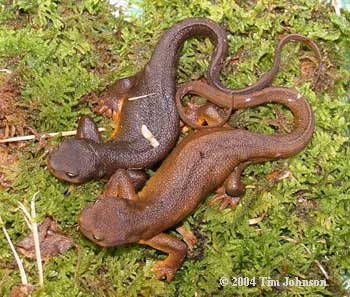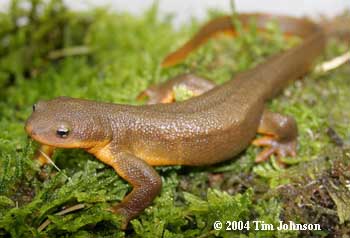| Taricha granulosa | |||||||||||||
| Rough-skinned Newt | |||||||||||||

|
|
Nomenclature
Rough-skinned newts are most commonly sold under the names "Oregon
newts" or "orange-bellied newts". These terms are
fictional names created by the pet trade. They do not even come
from Oregon, as that state does not allow commercial collecting
of newts for the pet trade. Instead, "Oregon" or "orange-bellied"
newts are either rough-skinned newts (Taricha granulosa)
or California newts (Taricha torosa), both collected from
California. Pet stores often do not (or cannot) distinguish
between the two species. This often leads to people incorrectly
identifying their newt, which in turns leads to improper care.
 T. g. granulosa |
 T. g. granulosa |
Description
This species is very similar to the California newt (Taricha torosa) but differs in having smaller eyes, yellow irises, a
V-shaped palatine tooth pattern, and uniformly dark eyelids. When
viewed from above, the eyes of T. granulosa do not protrude
beyond the profile of the head.
Two subspecies of T. granulosa are currently recognized:
Taricha granulosa granulosa: The rough-skinned newt ranges from light brown to olive to brownish-black above with a sharply contrasting yellow to orange belly. Some populations in California and Oregon contain individuals with dark blotching on the dorsum. They measure 12.7 to 21.6cm. The skin is granular but the males develop smooth skin during the breeding season. Males can also be distinguished from females by a swollen vent and cornified toe pads during the breeding season which appear as rough, black patches of skin.
Taricha granulosa mazamae: Called the Mazama or Crater Lake newt, the darker pigmentation of the dorsum of this subspecies encroaches on the brighter ventral coloration and can also have heavy dark blotches on the belly. It is only found in the waters and nearby woodlands of Crater Lake, Oregon. However, similar animals occur in abundance on Gravina Island, Alaska. Because of this, many researchers feel this is not a valid subspecies.
Like all newts, the skin of T. granulosa contains toxins that are used as a defense against predators. Rough-skinned newts are exceptionally potent in this regard, producing a powerful neurotoxin called tetrodotoxin. While these newts are perfectly harmless to handle for most people, the toxin has been known to irritate bare skin and mucous membranes of some individuals. One should be careful to wash one's hands after handling them as an accidental rubbing of the eyes afterward can be very painful, but is generally not serious. Humans have been documented to die after ingesting these newts.
 |
 |
Natural Range and Habitat
Coastal Pacific Northwest from southeast Alaska to the San
Francisco Bay area of California. Also isolated populations exist
in west-central Idaho and southeast Montana and are believed to
be introduced. Aquatic adults are found in ponds, lakes, stream
pools, and sluggish sections of creeks and rivers. These newts
generally avoid fast-moving water. Terrestrial adults and
juveniles inhabit adjacent woodlands where they live under logs,
rocks, and leaf debris. Juveniles leave the pond after
metamorphosis and do not return for up to 4-5 years.

T. granulosa breeding pond.
Housing
Rough-skinned newts are the most aquatic Taricha species.
Though aquatic adults may become terrestrial for months to years
at a time, this species can be treated as semi-aquatic, with some
individuals preferring to be more aquatic or terrestrial than
others. They will need a large tank with numerous rocks or
driftwood breaking the surface of the water or a planted land
area. In the wild, rough-skinned newts have been found in depths
from 1 inch to 12 meters, but tend to prefer cooler, deeper water.
Thus, the water level should be at least 8 cm and preferably 15 cm or more. It is essentially impossible to keep these newts too
deep in the standard glass aquaria available to the average
hobbyist. Keep at 18-21° C (60-70° F) for the summer and reduce
to around 10-14° C (40-50° F) for the winter.
Feeding
Rough-skinned newts are documented to prey upon amphipods,
insects, snails, leeches, and tadpoles in the wild. In captivity,
they will eat a variety of foods including small crickets,
nightcrawlers, earthworms, waxworms, and mealworms.
 T. granulosa in amplexus. Male is above. |
 T. granulosa mating ball observed in the wild. |
Breeding
Like all members of Taricha, the rough-skinned newt's
courtship consists of the male grasping a female in amplexus. To
accomplish this, the male wraps his limbs around the female's
body from above and holds her tightly and will rub her head with
his chin as well as periodically rub her abdomen and flanks with
his hinbdlimbs. This can last for many hours to several days.
Eventually, the male will dismount and deposit a spermatophore
and if the female is receptive, he will then guide her towards it.
If the female is unreceptive, she will gladly seize this
opportunity to escape the male's advances!
Amplexus often worries new owners who are not expecting breeding behavior from the males and/or have never heard of amplexus. The main fear is drowning, as the pair can remain submerged for hours and it can appear that the male will drown the female. However, neither will drown and both surface for air together. Males will also amplex other males (which often results in an irritated wrestling match) and even other species of newts. Some keepers have even reported males amplexing species of fish such as Plecostomus as well as inanimate objects like air pump tubing and filter uptake tubes.
Rough-skinned newts have been documented breeding in every month except November in the wild. Low-elevation populations breed from February to May while those in high elevations breed in late spring to early fall. Lowering their temperatures for the winter will promote courtship the following spring. The eggs are laid singly on roots, aquatic vegetation, and debris and are also toxic like the adults. Larvae metamorphose in 4 months to a year. The larvae and juveniles are easy to raise using the methods discussed in the Raising Caudates from Eggs article. The juveniles can require several years to reach maturity (4-5 years being average for wild populations) but this time is often reduced in captivity as a result of plentiful food.

|

|

T. granulosa in a defensive posture (unken reflex).
References
Efford, I. E. and K. Tsumura. 1973. A comparison of the food of salamanders and fish in Marion Lake, British Columbia. Transactions of the American Fisheries Society 1:33-47.
Farner, D. F. 1947. Notes on the food habits of the salamanders of Crater Lake, Oregon. Copeia 1947:259-261.
Garber, D. P. and C. E. Garber. 1978. A variant form of Taricha granulosa (Amphibia, Urodela, Salamandridae) from northwestern California. Journal of Herpetology 16:7-15.
Neisch, I. C. 1971. Comparison of size, structure, and distributional patterns of two salamander populations in Marion Lake, British Columbia. Journal of the Fisheries Research Board of Canada 28:49-58.
Stebbins, R. C. 1951. Amphibians of Western North America. University of California Press, Berkeley, California, p. 539
Additional Resources
CC Husbandry and Breeding of Taricha granulosa by Uwe Gerlach
©2000 Nate Nelson. Posted December 2000. Revised July 2002.
